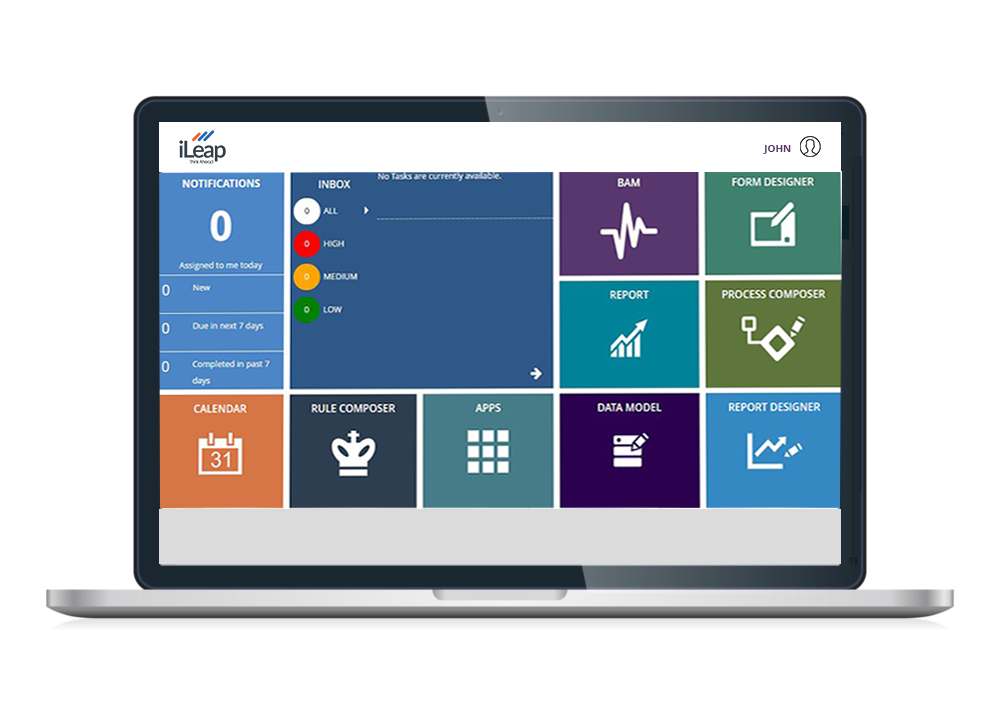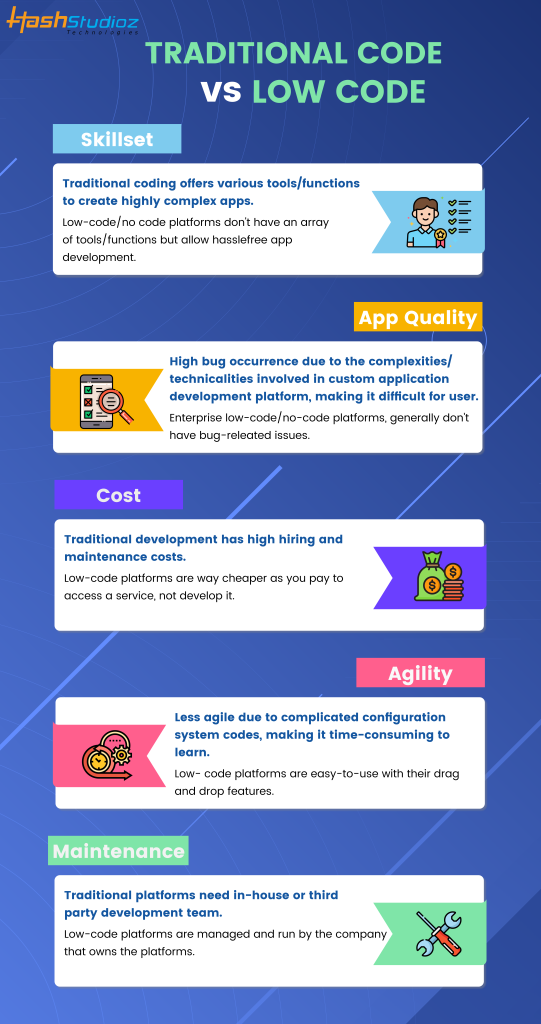Excellent Ideas For Deciding On Low-Code Platform Info
Excellent Ideas For Deciding On Low-Code Platform Info
Blog Article
Benefits Of Low-Code Application Development In Terms Of Speed
Visual Development Environment :
Drag-and-Drop Interfaces: Low-code platforms provide visual tools for designing applications. Drag-and-drop elements enable developers to rapidly build applications without having to write lengthy code.
Pre-built components and templates A lot of low-code platforms have pre-built components and templates that allow developers to quickly prototype and develop applications.
Reduced Coding Requirements:
Automated code generation: Low-code platforms produce the code base on visual models created and maintained by programmers. This eliminates the need to manually code, and speeds up development.
Reusable Components: Developers are able to use reusable components across different projects, minimizing the time they spend writing and testing code.
Collaboration streamlined:
Low-code development platforms are often equipped with tools such as deployment control, version control and testing. This enables seamless collaboration across teams.
Citizen Development: Business users as well as non-developers can help with application development by using intuitive interfaces, reducing the bottleneck that is often caused by the limited availability of professionals.
Rapid Iteration and Prototyping
Rapid Prototyping Developers are able to quickly develop prototypes to allow ideas to be validated and feedback gathered and analyzed, which leads to faster iterations.
Simple Modifications: Low-code development is oriented towards visuals, which makes it much easier to modify and update apps. It can also speed the process of developing and improving applications in response to user feedback.
Pre-built Integrations:
API Integrations. Low-code platforms usually have pre-built connectors and APIs for the most popular services which can reduce the amount of time required to connect other systems.
Data Integration: The integrated tools make it easier for connecting with databases and other sources, accelerating development.
Deployment and Scaling
One-Click Deployment: Many low-code platforms offer the option of deploying with one click, drastically decreasing the amount of time and effort required to deploy applications.
Cloud-based solutions: Cloud low-code platforms are capable of scaling and infrastructure management. Developers can focus on the functionality and logic of the application instead of deployment logistics.
The primary benefit of low-code application development, in terms of speed, is its ability to automatize and simplify many aspects of the process. This allows for quicker delivery of applications and quicker adaptations to changing needs. See the best Low-code Platform for application development recommendations for site info including azure sql, microsoft azure sql, low code platforms, build a docker container, push alerts, cross platform mobile dev, app modernisation, cross platform mobile app development, develop mobile application, azure sql server and more.
Benefits Of Low-Code Application Development In Security And Governance
Low-code software offers a variety of benefits in terms of cybersecurity and governance that are essential to ensure that all apps are managed, well-managed, and compliant throughout their lifespan. Here are a few key advantages.
Unified Management Console (UMC): Low-code platforms often provide a centralized management console where administrators can oversee and manage all the applications, ensuring consistent governance across the company.
Role-Based Access Control RBAC : These platforms usually include robust roles-based access controls, which permit administrators to define and enforce rules. It makes sure that only users who have authorization are able to alter or gain access to specific areas of the software.
Compliance and Regulatory Adherence:
Many low-code platforms include integrated compliance features. For example, they are built in line with industry standards as well as regulations and laws (e.g. HIPAA, GDPR). They have frameworks and tools to help ensure that apps meet the requirements of these regulations.
Audit Trails and Logging: Audit trails and logs that are comprehensive are usually integrated, allowing organizations to monitor changes, track access and make sure that they are in compliance with internal and external rules and regulations.
Improve Security Measures
Data encryption. Low code platforms usually offer built-in encrypted data when in transit as well as when in rest. This protects sensitive information.
Security Certifications Many low-code sellers have security certifications (e.g. ISO 27001, SOC 2 ) that demonstrate conformity to the highest security standards. This provides additional assurance for the customers.
Automated Security Updates:
Regular Updates and Patches Low code platforms typically are equipped to handle security patches and updates regularly. This means that apps remain protected from the latest security threats, and without developers having to manually alter their settings.
Security Monitoring: Continuous security monitoring tools are integrated to give real-time alerts and insights on potential security concerns.
Data Governance
Data Access Policies: These software tools enable organisations to define, enforce and monitor data policies. This will ensure that the data is only accessible to authorized users and are used correctly.
Data Masking, anonymization, and Anonymization Tools: These programs help protect sensitive personal information and are especially useful in testing environments.
Consistent Lifecycle Management of Applications
Development and Deployment pipelines: Lowcode platforms typically provide integrated development-and-deployment pipelines with security checks. They provide security throughout the entire lifecycle of an application.
Version Control: Integrated version control enables the management of changes. It also ensures that all changes to the software can be tracked, and if needed reversed. This is to ensure the integrity of the software.
User Authentication and Authorization:
Single Sign-On - Support for single sign-on (SSO), and other advanced mechanisms of authentication, simplifies management and increases security.
Multi-Factor Authentication : Many platforms include built-in multi-factor support, adding additional security when accessing apps.
Monitoring of Policy Enforcement
Low-code platforms are often designed with policies that are pre-defined to help organizations implement security and governance policies quickly.
Compliance Monitoring Tools - These instruments permit constant monitoring of compliance status, and also provide the ability to report, making it easier to find and correct any issues that might arise.
Integration into Existing Security Infrastructure:
Seamless Integration: Low-code platforms have been designed to work with current security software and infrastructure, such as identity management systems, SIEM (Security Information and Event Management) solutions, and firewalls.
API Security: Built-in API security features protect information, guarantee integrity of the application and provide secure integrations.
Training and the best practices
Guided Best Practices: A number of platforms offer guidelines and best methods for secure application development that help developers who are not developers to adhere to security guidelines.
Some lowcode providers offer assistance and security training to users to learn how to create and maintain a secure application.
Low-code development provides a variety of benefits for governance and security which ensure that apps are developed and maintained in a timely safe and secure manner. These platforms offer the frameworks and tools needed to protect sensitive data and enforce policies while maintaining regulatory compliance. Follow the recommended the full report about Enterprise application development with Low-code Platform for blog advice including rapid action development, azure sql server, develop mobile application, azure sql server, paas service, low code development platforms, software for app development, azure sql databases, rapid application design, rad application development and more.
The Benefits Of Developing Low-Code To Collaborate And Streamline Workflow
The low-code approach to development of applications provides numerous advantages in terms of collaboration and workflow, which makes it a great option for businesses looking to boost team productivity and streamlining their development processes. These are the primary benefits.
Unified Development Environment: Low-code platforms provide a single, unified environment where team members such as business analysts, developers, designers, and stakeholders, can collaborate effectively. This helps eliminate any silos.
Visual Development Tools: The visual drag-and-drop design of low-code tools makes it simpler for non-technical team members to participate in the development process, ensuring that the business needs are precisely recorded and implemented.
Improved Communication
Real-Time Collaboration Many low-code applications offer real-time capabilities, like commenting and editing simultaneously, or instant feedback. This allows for constant communication and can help reduce the time that is spent in back-and forth discussions.
Shared Workspaces Teams can collaborate by sharing workspaces. They can use these workspaces to edit, view and collaborate on project elements.
Streamlined Workflow Management:
Built-in project management Tools: Lowcode platforms often come equipped with integrated tools that assist teams in planning, tracking, and coordinating their progress. This includes task assignment as well as progress tracking and deadline management.
Workflow automation: Automating routine workflows and activities decreases the chance of errors and manual work which allows teams and individuals to focus more on strategic initiatives and improve efficiency.
More frequent iteration cycles:
Rapid prototyping: Low-code platforms allow for rapid prototyping, iterative development and quick prototyping, which allows teams to develop applications that are tested, then refine the applications in shorter time. This allows feedback to be quickly integrated and improvements are made.
Agile Development Support: Support for agile methodologies allows teams to work in sprints, continuously delivering small increments of functionality and making it easier to adjust to evolving requirements.
Accessibility for Non-Developers:
Citizens Development: Lowcode platforms allow people who use business software (citizen developers) to develop modifications, maintain, and create applications with no programming expertise. This makes it easier for IT teams and developers, enabling them to react more quickly to the demands of business.
Training and Onboarding - Intuitive interfaces, comprehensive training resources and intuitive interfaces make it easier to help new members to get up to speed and enhance the overall team's cooperation.
Centralized documentation and knowledge sharing
Documentation is integrated: Low code platforms are often equipped with features to create and maintain documentation within the platform, making it easy for all project details to be centralized.
Knowledge Repositories. Teams can create repository of knowledge, with templates and parts that can be reused. This will facilitate knowledge sharing and decrease duplication.
Consistency Standards, Standardization and Consistency:
Standardized Components: The use of standardized components that are pre-built and built provides an enduring consistency across applications. This makes it simpler for members of the team to comprehend the various components of a specific project and then work on these components.
Governance and Compliance - Built-in governance frameworks ensure that the development of every application conforms to the organizational standards as as the regulatory requirements. This helps to reduce non-compliance risk and assures that the applications meet the highest quality standards.
Feedback Loops and Improvement Loops
Integrated Feedback mechanisms: Low-code platform typically have a built-in feedback mechanism, which allows users to provide feedback on the application. Feedback can then become part of the development.
Continuous Improvement: The ability to quickly test deployment, change and deploy applications based on user feedback helps them align to the company's goals and users' demands.
Visualization, Reporting and Analysis
Real-Time Analytics built-in analytics and reporting tools offer real-time information on the progress of projects, their performance and user interaction that allow data-driven decision-making.
Visual Workflow Maps Software for mapping processes or workflows can be useful for teams to comprehend their workflows. They also help to identify the bottlenecks that are present, as well as areas that need improvement.
Low-code development of applications can be a very effective tool to collaborate and streamline workflow. It connects disparate teams, simplifies communication and automates processes. This encourages a collaborative environment with an agile and efficient development process that results in more high-quality apps as well as a more effective alignment between the business goals.